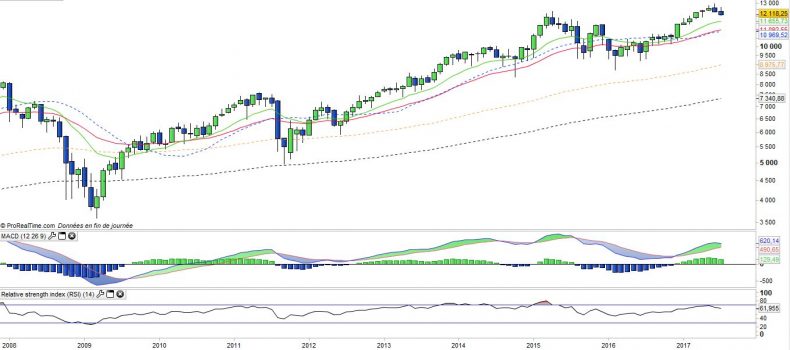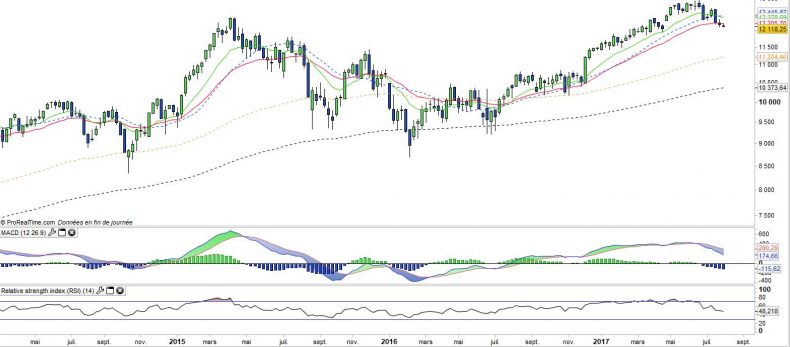Lyxor ETF DAX 30 (DAX) - 01/08/2017
Short term strategy : Negative (10%) / Trend -
Long term strategy : Positive (90%) / Trend -
Characteristics of the ETF
The DAX ETF (Lyxor) replicates the DAX 30 index, which is composed of the 30 largest German stocks representative of the main sectors of the market, while stocks are selected according to the size of their market capitalization.
Concerning the index, it will be observed that the top 10 holdings are mainly large industrial stocks such as Siemens or Bayer, while only two financial stocks are present: Allianz and Deutsche Post, all in all a relatively narrow index, composed mainly of large industrial groups.
Unlike the English, French or Italian indices, the DAX also stands out by the absence of major oil groups that weigh heavily in the weighting of the CAC40, FTSE100 or FTSEMIB40, which is double edged according to the cycle specific to the energy sector. Moreover, financials weigh only 15% of the index, half of which for the insurance giant Allianz, the banking sector therefore has a low weighting, reflecting the well-known weakness of Deutsche Bank and Commerzbank. Conversely, the automotive and chemical sectors weigh heavier than in the other European indices, while the technology sector is mainly represented by SAP. In summary, the DAX is a fairly marked index from a sectoral point of view, which can make it evolve differently from other European indices.
The expenses of this ETF are moderate at 0.15%.
After a 6.9% increase in 2016, the DAX30 rose by 5.5% since the beginning of the year, less than the stoxx600 (+ 6.7%). The French elections strengthen the euro zone, which is positive for Germany which will see its own elections held in September with less stake because the 2 main CDU / SPD parties remain dominant on the domestic scene. German fundamentals are very strong (GDP growth around 2%, historically low unemployment rate at less than 6% and accelerated de-leveraging planned until 2020). The main risks concern the main customers of Germany, namely the UK which could suffer from the Brexit, the US in political uncertainty and China that remains in transition.
In the short term, the DAX30 has entered the consolidation phase. The German index is weaker than the Stoxx600 because it is less exposed to financials and minings, the German automotive sector has just been weakened by an EC case on a possible cartel and the chemical sector could suffer from rising commodities.
Monthly data
The analysis of the monthly charts shows a bullish index, but which nevertheless begins a wave of consolidation. This correction, which does not threaten the trend at this stage, is moving towards the averages. The EMA13 (11656 pts) constitutes a first support but usually the corrections will at least test the EMA26 (currently around 11200 pts) and last several months.
It is not impossible that this phase of correction will continue for some time, given the little velocity of this correction, before the fundamental trend regains its rights.
Weekly data
The analysis of the weekly charts shows more clearly the phase of correction in progress. Prices have already gone through the averages 13 and 26, which are now going downwards, as are the main oscillators. The designated target is the M100E which is about 7% lower at 11200 pts. The whole question is going to be how quickly the prices will reach their goal.
So far it is a correction without high volatility and therefore quite slow.
ETF Objective
DAX is a UCITS compliant ETF that aims to track the benchmark index DAX.
Characteristics
| Inception date | 01/06/2006 |
| Expenses | 0,15% |
| Issuer | Lyxor |
| Benchmark | Indice DAX 30 |
| Code/Ticker | DAX |
| ISIN | LU0252633754 |
| UCITS | Oui |
| EU-SD status | Out of Scope |
| Currency | € |
| Exchange | Euronext Paris |
| Assets Under Management | 1 021 M€ |
| Replication method | Direct (Physical) |
| PEA | Yes |
| SRD | Yes |
| Dividend | Capitalisation |
| Currency risk | No |
| Number of Holdings | 30 |
| Risk | 3/5 |
Country Breakdown
| Germany | 100% |
Sector Breakdown
| Consumer Discretionary | 18% |
| Financials | 17% |
| Health Care | 15% |
| Industrials | 14% |
| Materials | 13% |
| Information Technology | 11% |
| Telecom | 5% |
| Others | 7% |
Top Ten Holdings
| Siemens | 10% |
| Bayer | 9% |
| SAP | 9% |
| BASF | 8% |
| Allianz | 8% |
| Daimler | 6% |
| Deutsche Telekom | 5% |
| Adidas | 3% |
| Fresenius | 3% |
| Deutsche Post | 3% |


